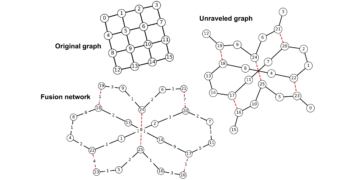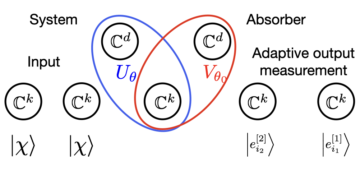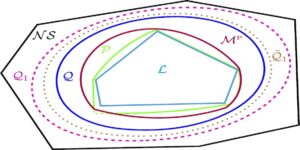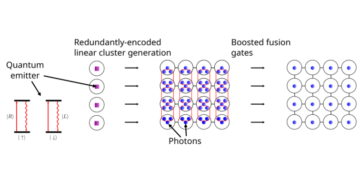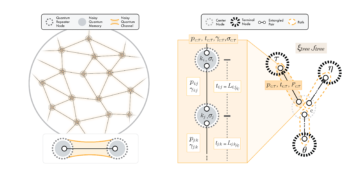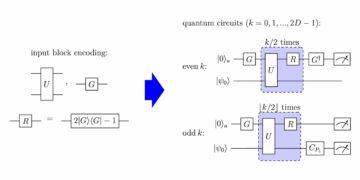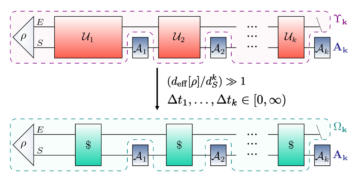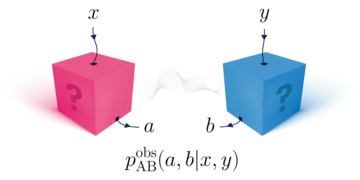1Perimeter Institute for Theoretical Physics, 31 Caroline St. N, Waterloo, Ontario, N2L 2Y5, Canada
2ICTQT, University of Gdańsk, Wita Stwosza 63, 80-308 Gdańsk, Poland
Find this paper interesting or want to discuss? Scite or leave a comment on SciRate.
Abstract
Recently, table-top experiments involving massive quantum systems have been proposed to test the interface of quantum theory and gravity. In particular, the crucial point of the debate is whether it is possible to conclude anything on the quantum nature of the gravitational field, provided that two quantum systems become entangled solely due to the gravitational interaction. Typically, this question has been addressed by assuming a specific physical theory to describe the gravitational interaction, but no systematic approach to characterise the set of possible gravitational theories which are compatible with the observation of entanglement has been proposed. Here, we remedy this by introducing the framework of Generalised Probabilistic Theories (GPTs) to the study of the nature of the gravitational field. This framework enables us to systematically study all theories compatible with the detection of entanglement generated via the gravitational interaction between two systems. We prove a no-go theorem stating that the following statements are incompatible: i) gravity is able to generate entanglement; ii) gravity mediates the interaction between the systems; iii) gravity is classical. We analyse the violation of each condition, in particular with respect to alternative non-linear models such as the Schrödinger-Newton equation and Collapse Models.
Featured image: Two test masses A and B become entangled over time via an interaction mediated by the gravitational field G.
Popular summary
In this paper we take a theory-independent approach which allows us to constrain the nature of the gravitational field independently of the specific model assumed for gravity. In order to do so, we introduce the tools of Generalised Probabilistic Theories to the study of the gravitational field. We prove a no-go theorem which makes precise exactly which properties of the gravitational field are consistent with the observation of gravitationally induced entanglement. The strength of this approach is to provide a method to test the internal consistency of different assumptions. One possibility we find is that the gravitational field need not be quantum, but could be described by some other non-classical theory.
► BibTeX data
► References
[1] Cécile M. DeWitt and Dean Rickles. “The role of gravitation in physics: Report from the 1957 chapel hill conference”. Volume 5. epubli. (2011).
https://doi.org/10.34663/9783945561294-00
[2] H Dieter Zeh. “Feynman’s interpretation of quantum theory”. The European Physical Journal H 36, 63–74 (2011).
https://doi.org/10.1007/978-3-642-21890-3_14
[3] LH Ford. “Gravitational radiation by quantum systems”. Annals of Physics 144, 238–248 (1982).
https://doi.org/10.1016/0003-4916(82)90115-4
[4] Netanel H Lindner and Asher Peres. “Testing quantum superpositions of the gravitational field with Bose-Einstein condensates”. Physical Review A 71, 024101 (2005).
https://doi.org/10.1103/PhysRevA.71.024101
[5] Dvir Kafri and JM Taylor. “A noise inequality for classical forces” (2013). arXiv:1311.4558.
arXiv:1311.4558
[6] D Kafri, JM Taylor, and GJ Milburn. “A classical channel model for gravitational decoherence”. New Journal of Physics 16, 065020 (2014).
https://doi.org/10.1088/1367-2630/16/6/065020
[7] Natacha Altamirano, Paulina Corona-Ugalde, Robert B Mann, and Magdalena Zych. “Gravity is not a pairwise local classical channel”. Classical and Quantum Gravity 35, 145005 (2018).
https://doi.org/10.1088/1361-6382/aac72f
[8] Charis Anastopoulos and Bei-Lok Hu. “Probing a gravitational cat state”. Classical and Quantum Gravity 32, 165022 (2015).
https://doi.org/10.1088/0264-9381/32/16/165022
[9] Charis Anastopoulos and Bei-Lok Hu. “Quantum superposition of two gravitational cat states”. Classical and Quantum Gravity 37, 235012 (2020).
https://doi.org/10.1088/1361-6382/abbe6f
[10] Alexander Wilce. “When Cavendish meets Feynman: A quantum torsion balance for testing the quantumness of gravity” (2017). arXiv:1710.08695.
arXiv:1710.08695
[11] M Bahrami, A Bassi, S McMillen, M Paternostro, and H Ulbricht. “Is gravity quantum?” (2015).
arXiv:1507.05733
[12] Alessio Belenchia, Robert M Wald, Flaminia Giacomini, Esteban Castro-Ruiz, Časlav Brukner, and Markus Aspelmeyer. “Quantum superposition of massive objects and the quantization of gravity”. Physical Review D 98, 126009 (2018).
https://doi.org/10.1103/PhysRevD.98.126009
[13] Alessio Belenchia, Robert M Wald, Flaminia Giacomini, Esteban Castro-Ruiz, Časlav Brukner, and Markus Aspelmeyer. “Information content of the gravitational field of a quantum superposition”. International Journal of Modern Physics D 28, 1943001 (2019).
https://doi.org/10.1142/S0218271819430016
[14] Marios Christodoulou and Carlo Rovelli. “On the possibility of laboratory evidence for quantum superposition of geometries”. Physics Letters B 792, 64–68 (2019).
https://doi.org/10.1016/j.physletb.2019.03.015
[15] Richard Howl, Vlatko Vedral, Devang Naik, Marios Christodoulou, Carlo Rovelli, and Aditya Iyer. “Non-gaussianity as a signature of a quantum theory of gravity”. PRX Quantum 2, 010325 (2021).
https://doi.org/10.1103/PRXQuantum.2.010325
[16] Ryan J Marshman, Anupam Mazumdar, and Sougato Bose. “Locality and entanglement in table-top testing of the quantum nature of linearized gravity”. Physical Review A 101, 052110 (2020).
https://doi.org/10.1103/PhysRevA.101.052110
[17] Tanjung Krisnanda, Guo Yao Tham, Mauro Paternostro, and Tomasz Paterek. “Observable quantum entanglement due to gravity”. npj Quantum Information 6, 1–6 (2020).
https://doi.org/10.1038/s41534-020-0243-y
[18] Sougato Bose, Anupam Mazumdar, Gavin W Morley, Hendrik Ulbricht, Marko Toroš, Mauro Paternostro, Andrew A Geraci, Peter F Barker, MS Kim, and Gerard Milburn. “Spin entanglement witness for quantum gravity”. Physical Review Letters 119, 240401 (2017).
https://doi.org/10.1103/PhysRevLett.119.240401
[19] Chiara Marletto and Vlatko Vedral. “Gravitationally induced entanglement between two massive particles is sufficient evidence of quantum effects in gravity”. Physical Review Letters 119, 240402 (2017).
https://doi.org/10.1103/PhysRevLett.119.240402
[20] Michael JW Hall and Marcel Reginatto. “On two recent proposals for witnessing nonclassical gravity”. Journal of Physics A: Mathematical and Theoretical 51, 085303 (2018).
https://doi.org/10.1088/1751-8121/aaa734
[21] C Anastopoulos and Bei-Lok Hu. “Comment on “a spin entanglement witness for quantum gravity” and on “gravitationally induced entanglement between two massive particles is sufficient evidence of quantum effects in gravity”” (2018). arXiv:1804.11315.
arXiv:1804.11315
[22] Chiara Marletto and Vlatko Vedral. “Why we need to quantise everything, including gravity”. npj Quantum Information 3, 1–5 (2017).
https://doi.org/10.1038/s41534-017-0028-0
[23] Chiara Marletto and Vlatko Vedral. “Witnessing nonclassicality beyond quantum theory”. Phys. Rev. D 102, 086012 (2020).
https://doi.org/10.1103/PhysRevD.102.086012
[24] Howard Barnum, Jonathan Barrett, Lisa Orloff Clark, Matthew Leifer, Robert Spekkens, Nicholas Stepanik, Alex Wilce, and Robin Wilke. “Entropy and information causality in general probabilistic theories”. New Journal of Physics 12, 033024 (2010).
https://doi.org/10.1088/1367-2630/14/12/129401
[25] Giulio Chiribella and Carlo Maria Scandolo. “Entanglement and thermodynamics in general probabilistic theories”. New Journal of Physics 17, 103027 (2015).
https://doi.org/10.1088/1367-2630/17/10/103027
[26] Giulio Chiribella and Carlo Maria Scandolo. “Microcanonical thermodynamics in general physical theories”. New Journal of Physics 19, 123043 (2017).
https://doi.org/10.1088/1367-2630/aa91c7
[27] Howard Barnum, Jonathan Barrett, Marius Krumm, and Markus P Müller. “Entropy, majorization and thermodynamics in general probabilistic theories”. EPTCS 195, 43–58 (2015).
https://doi.org/10.4204/EPTCS.195.4
[28] Ciarán M Lee and John H Selby. “Higher-order interference in extensions of quantum theory”. Foundations of Physics 47, 89–112 (2017).
https://doi.org/10.1007/s10701-016-0045-4
[29] Andrew JP Garner. “Interferometric computation beyond quantum theory”. Foundations of Physics 48, 886–909 (2018).
https://doi.org/10.1007/s10701-018-0142-7
[30] Howard Barnum, Markus P Müller, and Cozmin Ududec. “Higher-order interference and single-system postulates characterizing quantum theory”. New Journal of Physics 16, 123029 (2014).
https://doi.org/10.1088/1367-2630/16/12/123029
[31] B Dakić, Tomasz Paterek, and Č Brukner. “Density cubes and higher-order interference theories”. New Journal of Physics 16, 023028 (2014).
https://doi.org/10.1088/1367-2630/16/2/023028
[32] Howard Barnum, Ciarán M Lee, Carlo Maria Scandolo, and John H Selby. “Ruling out higher-order interference from purity principles”. Entropy 19, 253 (2017).
https://doi.org/10.3390/e19060253
[33] Sebastian Horvat and Borivoje Dakić. “Interference as an information-theoretic game”. Quantum 5, 404 (2021).
https://doi.org/10.22331/q-2021-03-08-404
[34] Jonathan G Richens, John H Selby, and Sabri W Al-Safi. “Entanglement is necessary for emergent classicality in all physical theories”. Physical Review Letters 119, 080503 (2017).
https://doi.org/10.1103/PhysRevLett.119.080503
[35] Ciarán M Lee and John H Selby. “A no-go theorem for theories that decohere to quantum mechanics”. Proceedings of the Royal Society A: Mathematical, Physical and Engineering Sciences 474, 20170732 (2018).
https://doi.org/10.1098/rspa.2017.0732
[36] Carlo Maria Scandolo, Roberto Salazar, Jarosław K. Korbicz, and Paweł Horodecki. “Universal structure of objective states in all fundamental causal theories”. Phys. Rev. Research 3, 033148 (2021).
https://doi.org/10.1103/PhysRevResearch.3.033148
[37] John Selby and Bob Coecke. “Leaks: quantum, classical, intermediate and more”. Entropy 19, 174 (2017).
https://doi.org/10.3390/e19040174
[38] Ciarán M Lee and Jonathan Barrett. “Computation in generalised probabilisitic theories”. New Journal of Physics 17, 083001 (2015).
https://doi.org/10.1088/1367-2630/17/8/083001
[39] Jonathan Barrett, Niel de Beaudrap, Matty J. Hoban, and Ciarán M. Lee. “The computational landscape of general physical theories”. npj Quantum Information 5 (2019).
https://doi.org/10.1038/s41534-019-0156-9
[40] Marius Krumm and Markus P Müller. “Quantum computation is the unique reversible circuit model for which bits are balls”. npj Quantum Information 5, 1–8 (2019).
https://doi.org/10.1038/s41534-018-0123-x
[41] Ciarán M Lee and John H Selby. “Generalised phase kick-back: the structure of computational algorithms from physical principles”. New Journal of Physics 18, 033023 (2016).
https://doi.org/10.1088/1367-2630/18/3/033023
[42] Ciarán M Lee and John H Selby. “Deriving Grover’s lower bound from simple physical principles”. New Journal of Physics 18, 093047 (2016).
https://doi.org/10.1088/1367-2630/18/9/093047
[43] Howard Barnum, Ciarán M Lee, and John H Selby. “Oracles and query lower bounds in generalised probabilistic theories”. Foundations of physics 48, 954–981 (2018).
https://doi.org/10.1007/s10701-018-0198-4
[44] Markus P Müller and Cozmin Ududec. “Structure of reversible computation determines the self-duality of quantum theory”. Physical Review Letters 108, 130401 (2012).
https://doi.org/10.1103/PhysRevLett.108.130401
[45] Jamie Sikora and John Selby. “Simple proof of the impossibility of bit commitment in generalized probabilistic theories using cone programming”. Physical Review A 97, 042302 (2018).
https://doi.org/10.1103/PhysRevA.97.042302
[46] John H Selby and Jamie Sikora. “How to make unforgeable money in generalised probabilistic theories”. Quantum 2, 103 (2018).
https://doi.org/10.22331/q-2018-11-02-103
[47] Jamie Sikora and John H. Selby. “Impossibility of coin flipping in generalized probabilistic theories via discretizations of semi-infinite programs”. Phys. Rev. Research 2, 043128 (2020).
https://doi.org/10.1103/PhysRevResearch.2.043128
[48] Howard Barnum, Oscar CO Dahlsten, Matthew Leifer, and Ben Toner. “Nonclassicality without entanglement enables bit commitment”. In Information Theory Workshop, 2008. ITW’08. IEEE. Pages 386–390. IEEE (2008).
https://doi.org/10.1109/ITW.2008.4578692
[49] Ludovico Lami, Carlos Palazuelos, and Andreas Winter. “Ultimate data hiding in quantum mechanics and beyond”. Communications in Mathematical Physics 361, 661–708 (2018).
https://doi.org/10.1007/s00220-018-3154-4
[50] Jonathan Barrett, Lucien Hardy, and Adrian Kent. “No signaling and quantum key distribution”. Physical Review Letters 95, 010503 (2005).
https://doi.org/10.1103/PhysRevLett.95.010503
[51] David Schmid, John H Selby, Matthew F Pusey, and Robert W Spekkens. “A structure theorem for generalized-noncontextual ontological models” (2020). arXiv:2005.07161.
arXiv:2005.07161
[52] David Schmid, John H. Selby, Elie Wolfe, Ravi Kunjwal, and Robert W. Spekkens. “Characterization of noncontextuality in the framework of generalized probabilistic theories”. PRX Quantum 2, 010331 (2021).
https://doi.org/10.1103/PRXQuantum.2.010331
[53] Farid Shahandeh. “Contextuality of general probabilistic theories”. PRX Quantum 2, 010330 (2021).
https://doi.org/10.1103/PRXQuantum.2.010330
[54] Giulio Chiribella and Xiao Yuan. “Measurement sharpness cuts nonlocality and contextuality in every physical theory” (2014). arXiv:1404.3348.
arXiv:1404.3348
[55] Joonwoo Bae, Dai-Gyoung Kim, and Leong-Chuan Kwek. “Structure of optimal state discrimination in generalized probabilistic theories”. Entropy 18, 39 (2016).
https://doi.org/10.3390/e18020039
[56] Howard Barnum and Alexander Wilce. “Information processing in convex operational theories”. Electronic Notes in Theoretical Computer Science 270, 3–15 (2011).
https://doi.org/10.1016/j.entcs.2011.01.002
[57] Jonathan Barrett. “Information processing in generalized probabilistic theories”. Physical Review A 75, 032304 (2007).
https://doi.org/10.1103/PhysRevA.75.032304
[58] Anna Jenčová and Martin Plávala. “Conditions on the existence of maximally incompatible two-outcome measurements in general probabilistic theory”. Physical Review A 96, 022113 (2017).
https://doi.org/10.1103/PhysRevA.96.022113
[59] Howard Barnum, Jonathan Barrett, Matthew Leifer, and Alexander Wilce. “Generalized no-broadcasting theorem”. Physical Review letters 99, 240501 (2007).
https://doi.org/10.1103/PhysRevLett.99.240501
[60] Howard Barnum, Jonathan Barrett, Matthew Leifer, and Alexander Wilce. “Teleportation in general probabilistic theories”. In Proceedings of Symposia in Applied Mathematics. Volume 71, pages 25–48. (2012).
https://doi.org/10.48550/arXiv.0805.3553
[61] Howard Barnum, Carl Philipp Gaebler, and Alexander Wilce. “Ensemble steering, weak self-duality, and the structure of probabilistic theories”. Foundations of Physics 43, 1411–1427 (2013).
https://doi.org/10.1007/s10701-013-9752-2
[62] Teiko Heinosaari, Leevi Leppäjärvi, and Martin Plávala. “No-free-information principle in general probabilistic theories”. Quantum 3, 157 (2019).
https://doi.org/10.22331/q-2019-07-08-157
[63] Ł. Czekaj, M. Horodecki, and T. Tylec. “Bell measurement ruling out supraquantum correlations”. Phys. Rev. A 98, 032117 (2018).
https://doi.org/10.1103/PhysRevA.98.032117
[64] Howard Barnum, Salman Beigi, Sergio Boixo, Matthew B Elliott, and Stephanie Wehner. “Local quantum measurement and no-signaling imply quantum correlations”. Physical Review Letters 104, 140401 (2010).
https://doi.org/10.1103/PhysRevLett.104.140401
[65] Łukasz Czekaj, Ana Belén Sainz, John Selby, and Michał Horodecki. “Correlations constrained by composite measurements” (2020). arXiv:2009.04994.
arXiv:2009.04994
[66] Joe Henson, Raymond Lal, and Matthew F Pusey. “Theory-independent limits on correlations from generalized bayesian networks”. New Journal of Physics 16, 113043 (2014).
https://doi.org/10.1088/1367-2630/16/11/113043
[67] Mirjam Weilenmann and Roger Colbeck. “Analysing causal structures in generalised probabilistic theories”. Quantum 4, 236 (2020).
https://doi.org/10.22331/q-2020-02-27-236
[68] Ludovico Lami. “Non-classical correlations in quantum mechanics and beyond” (2018). arXiv:1803.02902.
arXiv:1803.02902
[69] Paulo J Cavalcanti, John H Selby, Jamie Sikora, Thomas D Galley, and Ana Belén Sainz. “Post-quantum steering is a stronger-than-quantum resource for information processing”. npj Quantum Information 8, 1–10 (2022).
https://doi.org/10.1038/s41534-022-00574-8
[70] Markus P. Mueller, Jonathan Oppenheim, and Oscar C.O. Dahlsten. “The black hole information problem beyond quantum theory”. Journal of High Energy Physics 2012 (2012).
https://doi.org/10.1007/jhep09(2012)116
[71] Lluís Masanes, Thomas D Galley, and Markus P Müller. “The measurement postulates of quantum mechanics are operationally redundant”. Nature Communications 10, 1–6 (2019).
https://doi.org/10.1038/s41467-019-09348-x
[72] Thomas D Galley and Lluis Masanes. “Classification of all alternatives to the Born rule in terms of informational properties”. Quantum 1, 15 (2017).
https://doi.org/10.22331/q-2017-07-14-15
[73] Thomas D Galley and Lluis Masanes. “Any modification of the Born rule leads to a violation of the purification and local tomography principles”. Quantum 2, 104 (2018).
https://doi.org/10.22331/q-2018-11-06-104
[74] Thomas D. Galley and Lluis Masanes. “How dynamics constrains probabilities in general probabilistic theories”. Quantum 5, 457 (2021).
https://doi.org/10.22331/q-2021-05-21-457
[75] Giulio Chiribella, Giacomo Mauro D’Ariano, and Paolo Perinotti. “Informational derivation of quantum theory”. Physical Review A 84, 012311 (2011).
https://doi.org/10.1103/PhysRevA.84.012311
[76] Giulio Chiribella. “Dilation of states and processes in operational-probabilistic theories”. EPTCS 172, 2014, pp. 1-14 172, 1–14 (2014).
https://doi.org/10.4204/EPTCS.172.1
[77] Giulio Chiribella. “Distinguishability and copiability of programs in general process theories”. International Journal of Software and Informatics 1:2, 1–14 (2014).
https://doi.org/10.48550/arXiv.1411.3035
[78] Howard Barnum and Alexander Wilce. “Local tomography and the jordan structure of quantum theory”. Foundations of Physics 44, 192–212 (2014).
https://doi.org/10.1007/s10701-014-9777-1
[79] Alexander Wilce. “Four and a half axioms for finite dimensional quantum mechanics” (2009). arXiv:0912.5530.
arXiv:0912.5530
[80] Alexander Wilce. “A royal road to quantum theory (or thereabouts)”. Entropy 20, 227 (2018).
https://doi.org/10.3390/e20040227
[81] Howard Barnum, Matthew A. Graydon, and Alexander Wilce. “Composites and Categories of Euclidean Jordan Algebras”. Quantum 4, 359 (2020).
https://doi.org/10.22331/q-2020-11-08-359
[82] Howard Barnum, Ross Duncan, and Alexander Wilce. “Symmetry, compact closure and dagger compactness for categories of convex operational models”. Journal of Philosophical Logic 42, 501–523 (2013).
https://doi.org/10.1007/s10992-013-9280-8
[83] Alexander Wilce. “Symmetry and composition in probabilistic theories”. Electronic Notes in Theoretical Computer Science 270, 191–207 (2011).
https://doi.org/10.1016/j.entcs.2011.01.031
[84] Lluís Masanes and Markus P Müller. “A derivation of quantum theory from physical requirements”. New Journal of Physics 13, 063001 (2011).
https://doi.org/10.1088/1367-2630/13/6/063001
[85] Lluís Masanes, Markus P Müller, Remigiusz Augusiak, and David Pérez-García. “Existence of an information unit as a postulate of quantum theory”. Proceedings of the National Academy of Sciences 110, 16373–16377 (2013).
https://doi.org/10.1073/pnas.1304884110
[86] Markus P Müller and Lluis Masanes. “Three-dimensionality of space and the quantum bit: an information-theoretic approach”. New Journal of Physics 15, 053040 (2013).
https://doi.org/10.1088/1367-2630/15/5/053040
[87] Giulio Chiribella, Giacomo Mauro D’Ariano, and Paolo Perinotti. “Quantum from principles”. In Quantum theory: informational foundations and foils. Pages 171–221. Springer (2016).
https://doi.org/10.1007/978-94-017-7303-4_6
[88] Martin Plávala. “General probabilistic theories: An introduction” (2021). arXiv:2103.07469.
arXiv:2103.07469
[89] Markus Müller. “Probabilistic theories and reconstructions of quantum theory”. SciPost Physics Lecture NotesPage 028 (2021).
https://doi.org/10.21468/SciPostPhysLectNotes.28
[90] L. Diósi. “Gravitation and quantum-mechanical localization of macro-objects”. Physics Letters A 105, 199–202 (1984).
https://doi.org/10.1016/0375-9601(84)90397-9
[91] G. C. Ghirardi, A. Rimini, and T. Weber. “Unified dynamics for microscopic and macroscopic systems”. Phys. Rev. D 34, 470–491 (1986).
https://doi.org/10.1103/PhysRevD.34.470
[92] Lajos Diosi. “A universal master equation for the gravitational violation of quantum mechanics”. Physics Letters A 120, 377–381 (1987).
https://doi.org/10.1016/0375-9601(87)90681-5
[93] Gian Carlo Ghirardi, Philip Pearle, and Alberto Rimini. “Markov processes in hilbert space and continuous spontaneous localization of systems of identical particles”. Phys. Rev. A 42, 78–89 (1990).
https://doi.org/10.1103/PhysRevA.42.78
[94] Roger Penrose. “On gravity’s role in quantum state reduction”. Gen. Rel. Grav. 28, 581–600 (1996).
https://doi.org/10.1007/BF02105068
[95] Angelo Bassi and GianCarlo Ghirardi. “Dynamical reduction models”. Physics Reports 379, 257–426 (2003).
https://doi.org/10.1016/S0370-1573(03)00103-0
[96] Stephen L Adler and Angelo Bassi. “Collapse models with non-white noises”. J Phys A 40, 15083–15098 (2007).
https://doi.org/10.1088/1751-8113/40/50/012
[97] MP Blencowe. “Effective field theory approach to gravitationally induced decoherence”. Phys. Rev. Lett. 111, 021302 (2013).
https://doi.org/10.1103/PhysRevLett.111.021302
[98] C. Anastopoulos and B. L. Hu. “A Master Equation for Gravitational Decoherence: Probing the Textures of Spacetime”. Class. Quant. Grav. 30, 165007 (2013). arXiv:1305.5231.
https://doi.org/10.1088/0264-9381/30/16/165007
arXiv:1305.5231
[99] Roger Penrose. “On the gravitization of quantum mechanics 1: Quantum state reduction”. Foundations of Physics 44, 557–575 (2014).
https://doi.org/10.1007/s10701-013-9770-0
[100] Angelo Bassi, André Großardt, and Hendrik Ulbricht. “Gravitational decoherence”. Class. Quant. Grav. 34, 193002 (2017).
https://doi.org/10.1088/1361-6382/aa864f
[101] Soham Pal, Priya Batra, Tanjung Krisnanda, Tomasz Paterek, and TS Mahesh. “Experimental localisation of quantum entanglement through monitored classical mediator”. Quantum 5, 478 (2021).
https://doi.org/10.22331/q-2021-06-17-478
[102] Bogdan Mielnik. “Generalized quantum mechanics”. Comm. Math. Phys. 37, 221–256 (1974).
https://doi.org/10.1007/BF01646346
[103] Roman V. Buniy, Stephen D.H. Hsu, and A. Zee. “Is Hilbert space discrete?”. Physics Letters B 630, 68–72 (2005).
https://doi.org/10.1016/j.physletb.2005.09.084
[104] Markus Mueller. “Does probability become fuzzy in small regions of spacetime?”. Physics Letters B 673, 166–167 (2009).
https://doi.org/10.1016/j.physletb.2009.02.017
[105] T. N. Palmer. “Discretisation of the Bloch Sphere, Fractal Invariant Sets and Bell’s Theorem” (2020). arXiv:1804.01734.
arXiv:1804.01734
[106] James Hefford and Stefano Gogioso. “Hyper-decoherence in density hypercubes”. EPTCS 340, 141–159 (2021).
https://doi.org/10.4204/EPTCS.340.7
[107] John H. Selby, Paulo Cavalcanti, and Ana Belén Sainz. “Extended boxworld: a generalised probabilistic theory for type independent common cause resources” (forthcoming).
[108] Stephen L. Adler and Angelo Bassi. “Is quantum theory exact?”. Science 325, 275–276 (2009).
https://doi.org/10.1126/science.1176858
[109] Lajos Diósi. “Models for universal reduction of macroscopic quantum fluctuations”. Phys. Rev. A 40, 1165 (1989).
https://doi.org/10.1103/PhysRevA.40.1165
[110] J. R. van Meter. “Schrodinger-Newton ‘collapse’ of the wave function”. Class. Quant. Grav. 28, 215013 (2011). arXiv:1105.1579.
https://doi.org/10.1088/0264-9381/28/21/215013
arXiv:1105.1579
[111] C Anastopoulos and BL Hu. “Problems with the newton–schrödinger equations”. New J. Phys. 16, 085007 (2014).
https://doi.org/10.1088/1367-2630/16/8/085007
[112] Chiara Marletto and Vlatko Vedral. “When can gravity path-entangle two spatially superposed masses?”. Physical Review D 98 (2018).
https://doi.org/10.1103/physrevd.98.046001
[113] M Reginatto and M J W Hall. “Quantum-classical interactions and measurement: a consistent description using statistical ensembles on configuration space”. Journal of Physics: Conference Series 174, 012038 (2009).
https://doi.org/10.1088/1742-6596/174/1/012038
[114] M.J.W. Hall and M. Reginatto. “Ensembles on configuration space: Classical, quantum, and beyond”. Fundamental Theories of Physics. Springer International Publishing. (2016). url: books.google.ca/books?id=NQxkDAAAQBAJ.
https://books.google.ca/books?id=NQxkDAAAQBAJ
[115] Michael Hall. personal communication.
[116] Bogdan Mielnik. “Mobility of nonlinear systems”. Journal of Mathematical Physics 21, 44–54 (1980).
https://doi.org/10.1063/1.524331
[117] Giacomo Mauro D’Ariano, Marco Erba, and Paolo Perinotti. “Classicality without local discriminability: Decoupling entanglement and complementarity”. Physical Review A 102, 052216 (2020).
https://doi.org/10.1103/PhysRevA.102.052216
[118] Giacomo Mauro D’Ariano, Marco Erba, and Paolo Perinotti. “Classical theories with entanglement”. Physical Review A 101, 042118 (2020).
https://doi.org/10.1103/PhysRevA.101.042118
[119] Christoph Simon, Vladimír Bužek, and Nicolas Gisin. “No-signaling condition and quantum dynamics”. Phys. Rev. Lett. 87, 170405 (2001).
https://doi.org/10.1103/PhysRevLett.87.170405
[120] Lluis Masanes. personal communication.
[121] Giulio Chiribella, Giacomo Mauro D’Ariano, and Paolo Perinotti. “Probabilistic theories with purification”. Physical Review A 81, 062348 (2010).
https://doi.org/10.1103/PhysRevA.81.062348
[122] Lucien Hardy. “Reformulating and reconstructing quantum theory” (2011). arXiv:1104.2066.
arXiv:1104.2066
[123] Andrea Mari, Giacomo De Palma, and Vittorio Giovannetti. “Experiments testing macroscopic quantum superpositions must be slow”. Scientific reports 6, 22777 (2016).
https://doi.org/10.1038/srep22777
Cited by
[1] Chon Man Sou, Duc Huy Tran, and Yi Wang, “Decoherence of Cosmological Perturbations from Boundary Terms and the Non-Classicality of Gravity”, arXiv:2207.04435.
[2] Martin Plávala, “General probabilistic theories: An introduction”, arXiv:2103.07469.
[3] Daniel Carney, Holger Müller, and Jacob M. Taylor, “Using an Atom Interferometer to Infer Gravitational Entanglement Generation”, PRX Quantum 2 3, 030330 (2021).
[4] Daniel Carney, “Newton, entanglement, and the graviton”, Physical Review D 105 2, 024029 (2022).
[5] Daniel Carney, Yanbei Chen, Andrew Geraci, Holger Müller, Cristian D. Panda, Philip C. E. Stamp, and Jacob M. Taylor, “Snowmass 2021 White Paper: Tabletop experiments for infrared quantum gravity”, arXiv:2203.11846.
[6] Marios Christodoulou, Andrea Di Biagio, Markus Aspelmeyer, Časlav Brukner, Carlo Rovelli, and Richard Howl, “Locally mediated entanglement through gravity from first principles”, arXiv:2202.03368.
[7] Anne-Catherine de la Hamette, Viktoria Kabel, Esteban Castro-Ruiz, and Časlav Brukner, “Falling through masses in superposition: quantum reference frames for indefinite metrics”, arXiv:2112.11473.
[8] Nick Huggett, Niels Linnemann, and Mike Schneider, “Quantum Gravity in a Laboratory?”, arXiv:2205.09013.
[9] Ludovico Lami, Bartosz Regula, Ryuji Takagi, and Giovanni Ferrari, “Framework for resource quantification in infinite-dimensional general probabilistic theories”, Physical Review A 103 3, 032424 (2021).
[10] Charis Anastopoulos, Michalis Lagouvardos, and Konstantina Savvidou, “Gravitational effects in macroscopic quantum systems: a first-principles analysis”, Classical and Quantum Gravity 38 15, 155012 (2021).
[11] Jonathan Oppenheim, Carlo Sparaciari, Barbara Šoda, and Zachary Weller-Davies, “Gravitationally induced decoherence vs space-time diffusion: testing the quantum nature of gravity”, arXiv:2203.01982.
[12] Peter Sidajaya, Wan Cong, and Valerio Scarani, “On the possibility of detecting gravity of an object frozen in a spatial superposition by the Zeno effect”, arXiv:2207.04017.
[13] Matt Wilson and Giulio Chiribella, “Causality in Higher Order Process Theories”, arXiv:2107.14581.
[14] Markus Aspelmeyer, “How to avoid the appearance of a classical world in gravity experiments”, arXiv:2203.05587.
[15] Jonathan Oppenheim, Carlo Sparaciari, Barbara Šoda, and Zachary Weller-Davies, “The two classes of hybrid classical-quantum dynamics”, arXiv:2203.01332.
[16] Onur Hosten, “Constraints on probing quantum coherence to infer gravitational entanglement”, Physical Review Research 4 1, 013023 (2022).
[17] Martin Plávala and Matthias Kleinmann, “Operational Theories in Phase Space: Toy Model for the Harmonic Oscillator”, Physical Review Letters 128 4, 040405 (2022).
[18] Massimo Cerdonio and Giovanni Carugno, “A superfluid He<SUP>4</SUP> version of a test on QG versus CG: feasibility with demonstrated methods”, Journal of Physics Communications 5 8, 085010 (2021).
[19] Huan Cao, Marc-Olivier Renou, Chao Zhang, Gaël Massé, Xavier Coiteux-Roy, Bi-Heng Liu, Yun-Feng Huang, Chuan-Feng Li, Guang-Can Guo, and Elie Wolfe, “Experimental Demonstration that No Tripartite-Nonlocal Causal Theory Explains Nature’s Correlations”, arXiv:2201.12754.
[20] Lin-Qing Chen, Flaminia Giacomini, and Carlo Rovelli, “Quantum States of Fields for Quantum Split Sources”, arXiv:2207.10592.
The above citations are from SAO/NASA ADS (last updated successfully 2022-08-17 22:42:14). The list may be incomplete as not all publishers provide suitable and complete citation data.
On Crossref’s cited-by service no data on citing works was found (last attempt 2022-08-17 22:42:11).
This Paper is published in Quantum under the Creative Commons Attribution 4.0 International (CC BY 4.0) license. Copyright remains with the original copyright holders such as the authors or their institutions.


